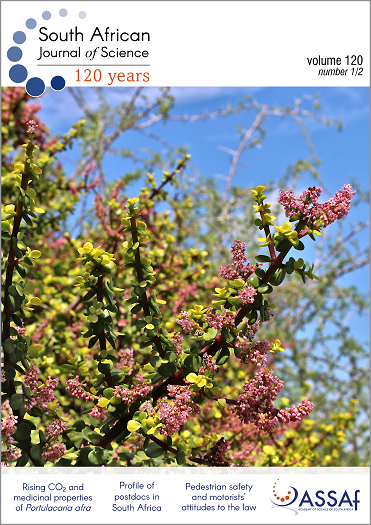Fusarium and fumonisin in GM maize grown by small-scale farmers in KwaZulu-Natal, South Africa
DOI:
https://doi.org/10.17159/sajs.2024/15905Keywords:
genetically modified maize, fumonisin, Fusarium, small-scale farmers, KwaZulu-NatalAbstract
The genetic modification (GM) of maize to contain proteins that act to control insects has become a widespread agricultural practice. Although the reduction of insect damage to maize ears could potentially increase crop yield, rural small-scale farmers might be reluctant to buy expensive GM seed every season even when the lower fungal infection of the GM maize might also result in health benefits. This study was conducted over 5 years in three districts of northern KwaZulu-Natal, South Africa, to study the Fusarium verticillioides and F. proliferatum infection and fumonisin contamination levels in Bt maize, Roundup- Ready® maize, conventional commercial maize and traditional landrace maize planted by rural farmers following their traditional agricultural practices. Mean Fusarium infection rates varied between 3.0% and 38.3% with large standard deviations. Fusarium infection was not significantly different (p>0.05) between the various genotypes, possibly due to the wide variation in results and low sample numbers. Although the fumonisin results also showed wide variation, the trend of contamination was lower in Bt maize compared to conventional commercial genotypes. The mean fumonisin levels in Bt hybrids were mostly <300 μg/kg, ensuring a safe maize supply in populations consuming maize as a dietary staple. The wide variations in Fusarium and fumonisin levels within each district point to the influence of local agricultural practices, local environmental conditions, and seasonal variations. Reducing exposure to fumonisins in these communities requires both further attention to the possible influence of these factors, as well as the use of appropriate post-harvest strategies.
Significance:
This study was the first in South Africa to follow rural farmers planting Bt and commercial maize hybrids as well as open-pollinated landrace maize, according to their traditional agricultural practices. The results show that in some instances the Bt maize had the lowest fumonisin levels.
Downloads
Published
Issue
Section
License

All articles are published under a Creative Commons Attribution 4.0 International Licence
Copyright is retained by the authors. Readers are welcome to reproduce, share and adapt the content without permission provided the source is attributed.
Disclaimer: The publisher and editors accept no responsibility for statements made by the authors
How to Cite
- Abstract 451
- PDF 665
- EPUB 381
- XML 361
- Supplementary material 349












.png)